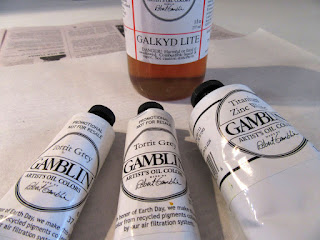 |
| Good bye, old paintings! |
Every painter at some point asks himself: What do I do with paintings I don't want anymore? This question seems to surface as the painter acquires more experience and a sense of what's good and what's not. Old paintings that no longer meet the new standard must be dealt with.
It's most important, for legacy's sake, that these paintings not be released into the wild. I know of more than one painter who has found his early work on eBay, much to the embarrassment of his ego and his bank account. And look at some of the immature work of famous artists, now gone, that has been uncovered. In many cases, the work should have been left in a drawer, lost forever. So, what to do?
You can burn it, but that's toxic. You can scar it with a knife and toss it, but it may be rescued and repaired. Or you can paint over it.
For many years, I thought painting over old oil paintings was risky, especially if you didn't understand the physics of paint. But there's a safe way to do it. First, make sure you are using only oil paint. Don't paint over dried oil paintings with acrylic; the acrylic is likely to delaminate over time. Second, don't try this with stretched canvas. Paint only over a painting on panel, not one on stretched canvas. Your new layers of paint will be, for quite some time, more flexible than the dry, more brittle paint below it, and this can cause structural problems with the paint film on a substrate that is prone to shrinking, expanding and flexing. Painting on panel may also help if you've used more “fat” (oil or medium) in those earlier layers. Finally, I would never paint over an old piece for what was going to become a Seriously Important Work. For that, I'd use nothing but new materials.
To cover old paintings, I've experimented with using both the alcohol-based version of Zinsser BIN, which contains shellac, and also the oil-based version of Kilz. (Don't use the latex, e.g. acrylic, versions.) Both of these have worked, but I always feel a little uneasy using non-artist-grade materials. So, here's my new process, which I feel more comfortable with.
I had several old 5x7s that I wanted to reuse for sketching. I also had on-hand a quantity of Gamblin Artist's Colors Torrit Grey that I'd been stockpiling over the years. (You can read the interesting story about Torrit Grey here.) My process was simple:
- I removed any varnish with Gamsol
- Any panels with too much texture I sanded lightly
- I mixed Torrit Grey with Titanium-Zinc White to make a more-or-less neutral, mid-value grey
- I mixed in about 50% more of Galkyd Lite to make it dry quickly
- I covered each panel with a thin brushing of the mixture
I'm curious to hear how you handle old paintings.
 |
| Torrit Grey, Galkyd Lite and Titanium Zinc White |
 |
| I mix all of this on a large sheet of palette paper |
 |
| I add Galkyd Lite to taste (about 1:2 of medium to paint) |
 |
| Paintings are now only a faint memory |
